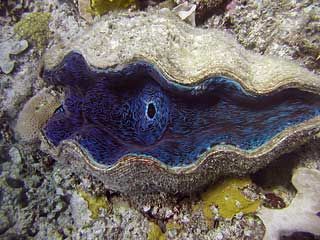Invertebrates: Giant Clam

Description
The Giant Clam (Tridacna gigas) or traditionally, pa’ua, is the largest living bivalve mollusc. One of a number of large clam species native to the shallow coral reefs of the South Pacific and Indian oceans, they weigh an average of 440 pounds and can measure as much as 1.5 meters across.
Permanently sessile in adulthood, the creature's siphon and mantle tissues act as a habitat for the green algae on which it feeds. By day, its shell remains open unless disturbed, and in this way the symbiotic algae may receive sunlight they need to grow.
The IUCN lists the giant clams as vulnerable. There is concern among conservationists for the sustainability of practices among those who use the animal as a source of livelihood. The numbers in the wild have been greatly reduced by extensive harvesting for food and aquarium trade. Illegal trade in giant clam shells for use as decorative accoutrements abounds, and the meat, called Himejako in Japan, is prized as a delicacy.



2 Comments:
Just came across your clam image and noticed you have it labeled as T. gigas but its actually a much rarer T. mbalavuana (tevoroa)
By Chris, at 15:14
Chris, at 15:14
Butterfly effect physics.Butterfly of the sea .see physic text
By Anonymous, at 19:41
Anonymous, at 19:41
Post a Comment
<< Home